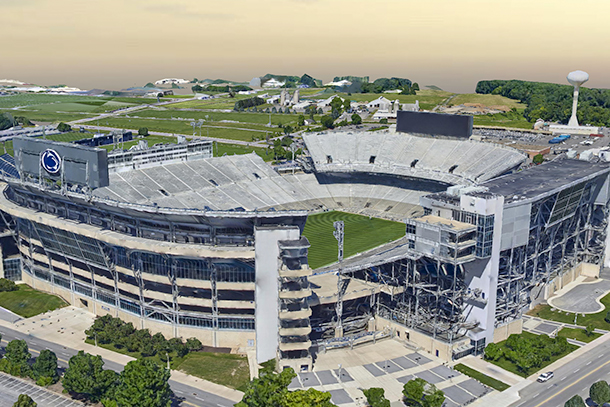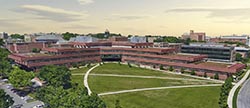
A virtual model of Beaver Stadium was designed by using photogrammerty software to create a 3D scalable reality mesh composed of vertices, lines and polygons. The mesh was then combined with data from various Penn State systems, including its building information modeling and geographic information system.
Researchers honored for virtual model of Penn State campus
Team creates real-time, virtual building mapping and monitoring system
11/27/2017
UNIVERSITY PARK, Pa. — Across its 21 campuses, Penn State owns and operates nearly 2,000 buildings and structures. Maintenance of these facilities, a large undertaking, must be constant and consistent in order to keep the University running smoothly.
John Messner, professor of architectural engineering, and Zhouqian Jiang, an architectural engineering doctoral candidate, partnered with Bentley Systems, Incorporated, a software development company that specialized in infrastructure design software, and Penn State Office of Physical Plant (OPP) to develop a real-time, virtual building mapping and monitoring system for Penn State.
Their work – a 3D virtual reality mesh model of campus – has been named a finalist for a 2017 Be Inspired award, an annual honor presented by Bentley recognizing astonishing work completed by its software users. The virtual model project was one of three finalists in the BIM Advancement in Reality Modeling category. The awards ceremony took place at the Year in Infrastructure 2017 Conference, held on October 10 -12 in Singapore. The team’s work will be recognized in the 2017 Year in Infrastructure yearbook.
Messner and Jiang worked with Bentley and OPP to capture thousands of aerial images of the 79-acre University Park campus. A small plane completed multiple fly-overs during the 2016 – 17 academic year to capture the photos needed to create the model.
These images were then processed using photogrammetry software, creating a 3D scalable reality mesh. The 3D mesh consists of vertices, lines and polygons that define the look and shape of a computerized rendering.
“The Context Capture software leverages photogrammetry approaches to extract 3-dimensional models by comparing consistent points across multiple photo images,” Messner said. “These points are then compiled into a 3D mesh, and approximated textures are placed on the mesh elements simulate reality.
The research team then combined the 3D mesh with data from Penn State’s building information modeling (BIM), geographic information system, and various other information systems to create the 3D virtual model of the University Park campus.
With this model, Penn State is able to provide its Office of Physical Plant (OPP) with the capability to track and monitor buildings across campus. The team is exploring methods to easily extract building information, including design models and systems information, for OPP engineers, operators and workers by simply clicking on the building in the 3D rendering.
“There are many valuable use cases for leveraging an interconnected model of our campus, Messner said. “We would like to get to a point where we can easily retrieve information about all the buildings, the infrastructure that supports the campus, and the real-time sensor data that is being collected from many sources.
The research team continues to work to improve and advance the virtual campus model. Research into connecting building systems to the model is underway. Soon, OPP workers may be able to track room environments and building security.
“We are continuing to explore better approaches to better integrate different facility information source. In addition, we are exploring the use of photogrammetry to track and document the construction progress of new buildings on campus,” Messner said. “We hope to someday, soon, have a comprehensive virtual campus model that will make it significantly easier to find information of facilities, and allow for more detailed data analytics on the performance of facilities across the campus.



 Virtual model of Millennium Science Complex
Virtual model of Millennium Science Complex
